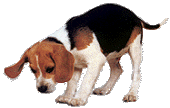|
|
 Welcome
to... Welcome
to...
Error-Free
Puppy Raising™
Tips
and
Positive Dog Parenting™
by Rolan Tripp, DVM and
Susan Tripp, MS
|
|
Welcome Guest!
Enroll to view
additional content.
Week 14 - Move It!
A handy word to teach your dog is to "move" (out of your way) especially
when your arms are full of groceries or other items.
Wrong Move: When
your dog is resting in a doorway or hallway, you walk around the dog
politely.
Week 15 - Stay the Course
When puppies reach about four months of age, the begin to lose their
puppy teeth and gain their adult teeth. They also become hormonal as
they mature. At this age, your puppy may appear to test you just like a
human adolescent or teenager. You ask your puppy to sit and
you get a blank stare or a wagging tail that looks like, "What if I
don't?"
Week 16 - Where's my Lollipop?
Just
like children, canines do learn that if something very good happens
right after something somewhat stressful, it may be worth it! Remember
the treasure chest in the dentist's office or the lollipop after your
child's first haircut?
Week 17
-Teach an Inhibited Bite
Veterinarian and founder of the APDT (Association of Pet Dog Trainers)
Dr. Ian Dunbar recommends teaching every puppy to have a "soft mouth"
and preventing serious aggression by teaching dogs to inhibit their
bites.
Week 18 -
Food Bowl Aggression
There
are several signs that your
puppy may be developing food
bowl aggression. Every canine is an individual.
Not every dog shows the same
signs in advance of a problem.
Some dogs never develop food
bowl or toy guarding.
Week 19
- Who's Telling Who What To Do?
Giving
food to the dog from the table lowers the human status in the pack.
Conversely, the dog’s position is elevated which makes it less likely he
will follow your command in the future, unless there is an immediate
pay off with food.
Week 20 -
Socializing Dogs to Cats
If you
have both dogs and cats in your home, it is best to introduce the newest
member of the family (cat or dog) slowly and with positive associations.
Praise curious, friendly behavior and offer both treats.
Week 21 -
English as a Second Language
Make sure you always use one
word to always mean one thing. For example, don't say, "Stay"
unless you expect your dog to freeze in one position until you say
otherwise! Don't say, "Down" unless you mean lie down in the down
position. Don't say, "No" if you mean, "Quiet".
Week 22 - The Interpreter
Behaviorist William Campbell
coined the "Interpretive Factor" and
"Jolly Routine" as an
effective way to model the desired
canine behavior.
Week
23 - Trading Up
Offering a treat in exchange for
an object in your canine's mouth is a
great way to begin teaching "drop" and
"give" and "fetch".
Week
24 - Rub-a-dub-dub, Bath Time!
Rub-a-dub-dub, teaching puppy to enjoy
the tub. The key is to start slowly with
lots of encouragement and rewards.
Week
25 - Sad Statistics
Don't be a sad
statistic, keep going with your
education about canine behavior! Here
are a few staggering statistics about
dog bites in the United States.
Week
26 - Puppy Frenzy
If
your puppy races around the house and
seems to have lost contact with planet
earth - then you are witnessing puppy
frenzy. Don't scold, give commands
or try to teach your puppy anything.
Instead, play, go for a run or give a
"cooling off" period.
Week
27 - Getting to Know You...
If you
would like to teach your canine to sit
quietly when the mail carrier arrives,
this topic is for you. with your
education about canine behavior! Here
are a few staggering statistics about
dog bites in the United States.
Week 28 - Stress Tolerance
It is
important that dogs learn that
experiencing a little stress is no big
deal so they will just "give up" and
relax and not allow the stress to
escalate.
Week
29 - Happy, Sad, or Mad?
You can learn to read your dog's
body language. Dog's usually show signs
of tension before they bite.
Week 30
- Relaxation Technique
Do
you wish you could help your puppy to
simply relax and enjoy being held?
This is possible, especially if you have
been doing gentling and leadership
exercises for some time and your pup has
already learned to trust you.
Week
31 - Fact or Fiction?
Do pets really love
us unconditionally? Fact or Fiction?
Pet's may show deference out of fear or
survival instinct but this isn't
unconditional love.
Week
32 - Little Dogs, Big Egos
Just like larger breeds, small breeds
require early, positive socialization,
gentle yet effective training methods,
plus for safety purposes they need to learn -
early on - that they are small dogs.
Week
33 - Say It Once
Try to give your canine one word cues to
help build an English vocabulary that is clear in sound and in
meaning. For example, say, you dog's name once, then the cue
(Come!). Praise any positive response (Goooood!) Look happy.
If no response, wait for your words to sink in. You may
need to clap or stamp your feet to get your dog's attention.
Then repeat.
Week
34 - Hands Off!
The
best training methods are "hands off."
This allows <<&key2>> to think and
figure out what your verbal cue and hand
signal mean. A food lure with a
clear, consistent hand signal speeds up
this process.
Week
35 - Extinction Burst
We call this the "extinction burst"
because the unwanted behavior increases
before your dog realizes it is no longer
working and gives it up, thereby making
the undesirable  behavior extinct. behavior extinct.
|
|
|